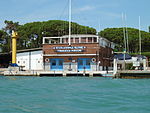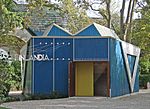San Servolo
Islands of the Venetian Lagoon

San Servolo is an Italian island in the Venetian Lagoon, to the southeast of San Giorgio Maggiore. Earlier housing a monastery of Benedictine monks, later an asylum for the insane, the island is now home to a museum, Venice International University, and the prestigious International College of Ca' Foscari University.
Excerpt from the Wikipedia article San Servolo (License: CC BY-SA 3.0, Authors, Images).San Servolo
Viale Vittorio Veneto, Venice Venezia-Murano-Burano
Geographical coordinates (GPS) Address Nearby Places Show on map
Geographical coordinates (GPS)
| Latitude | Longitude |
|---|---|
| N 45.418666 ° | E 12.357338 ° |
Address
Venice International University
Viale Vittorio Veneto
30132 Venice, Venezia-Murano-Burano
Veneto, Italy
Open on Google Maps










